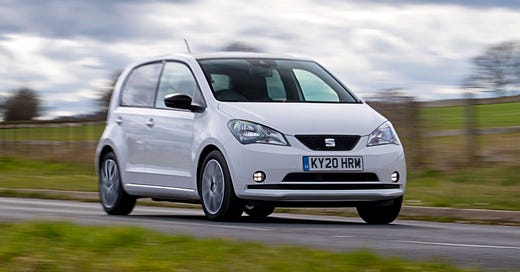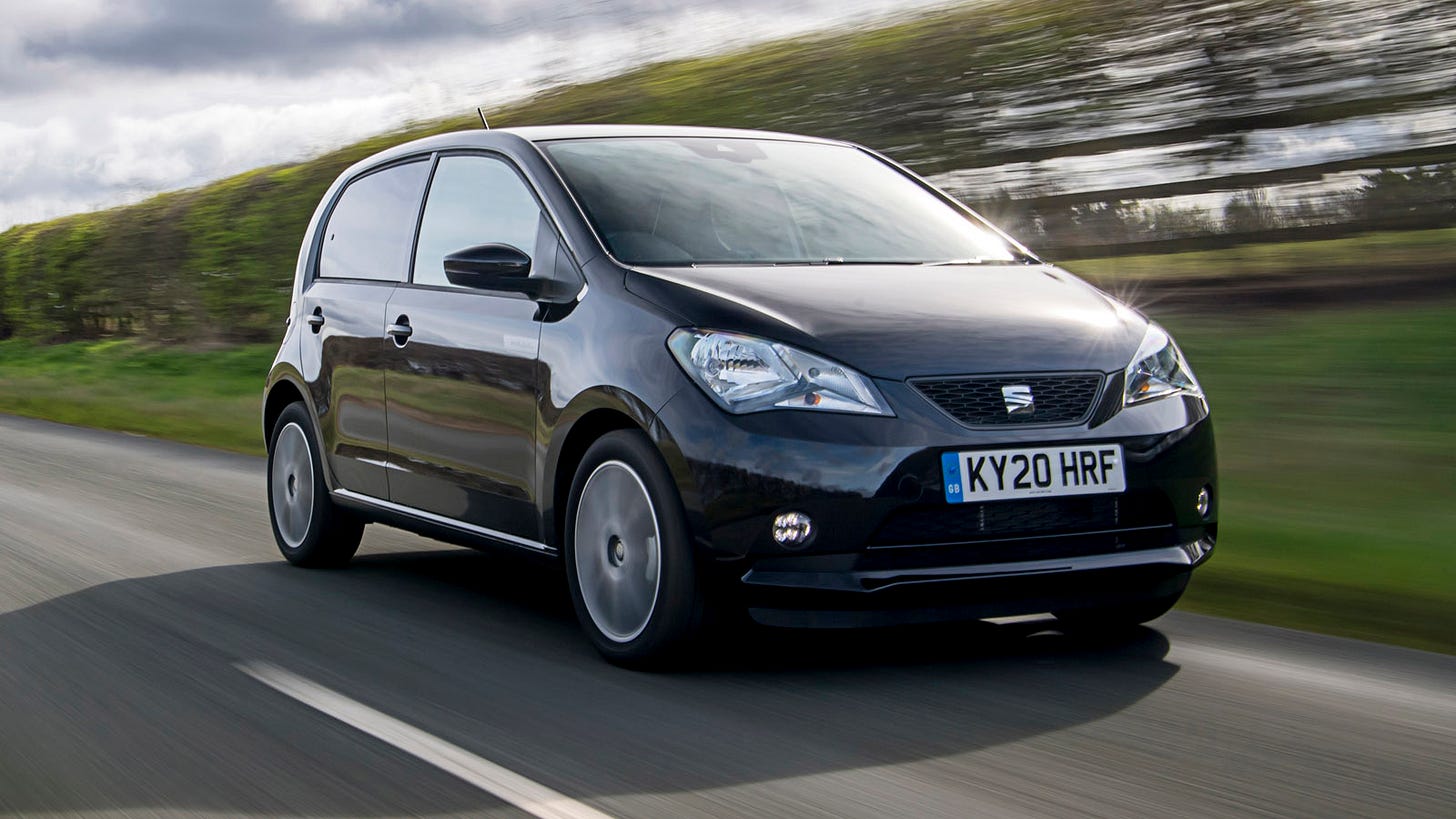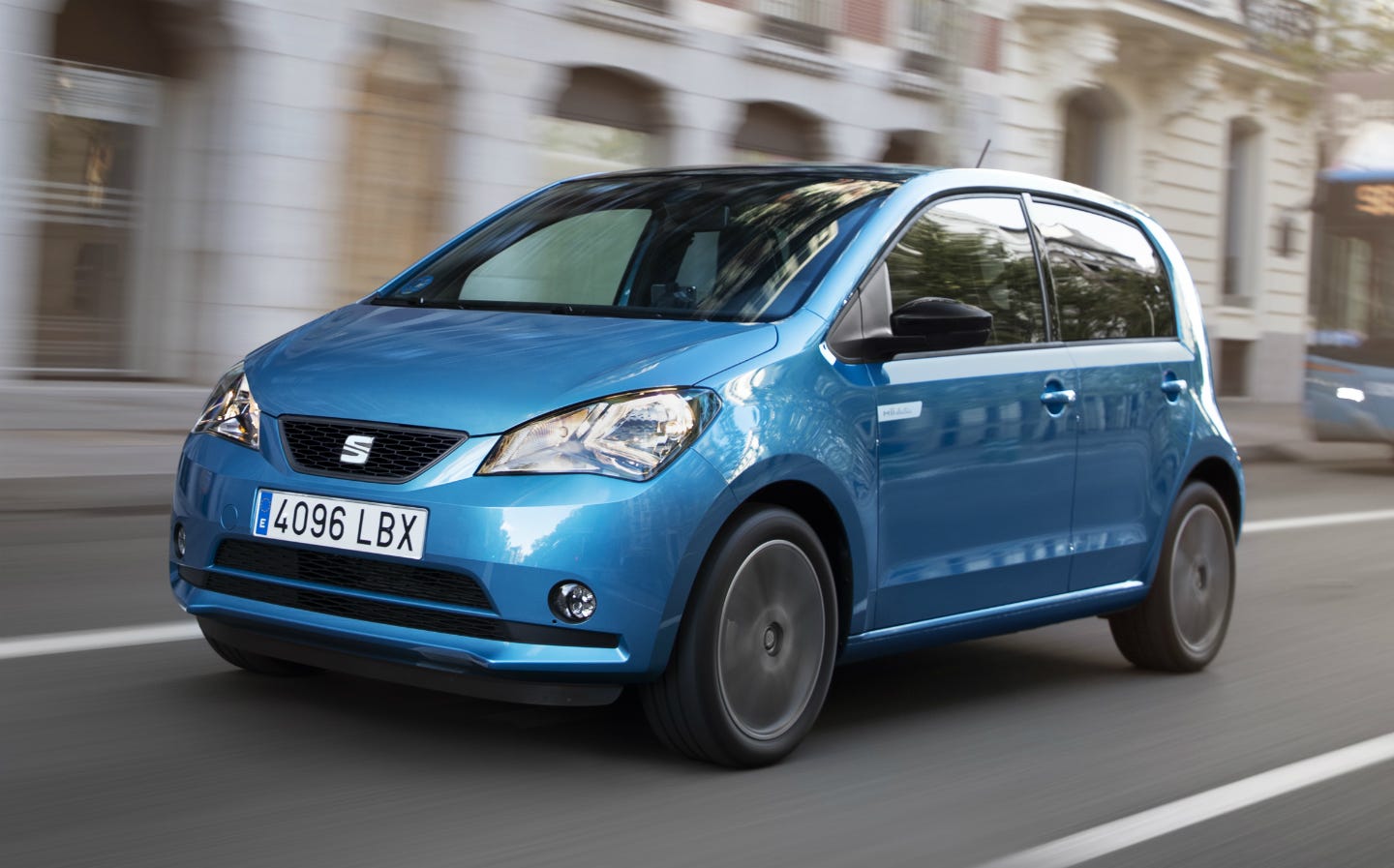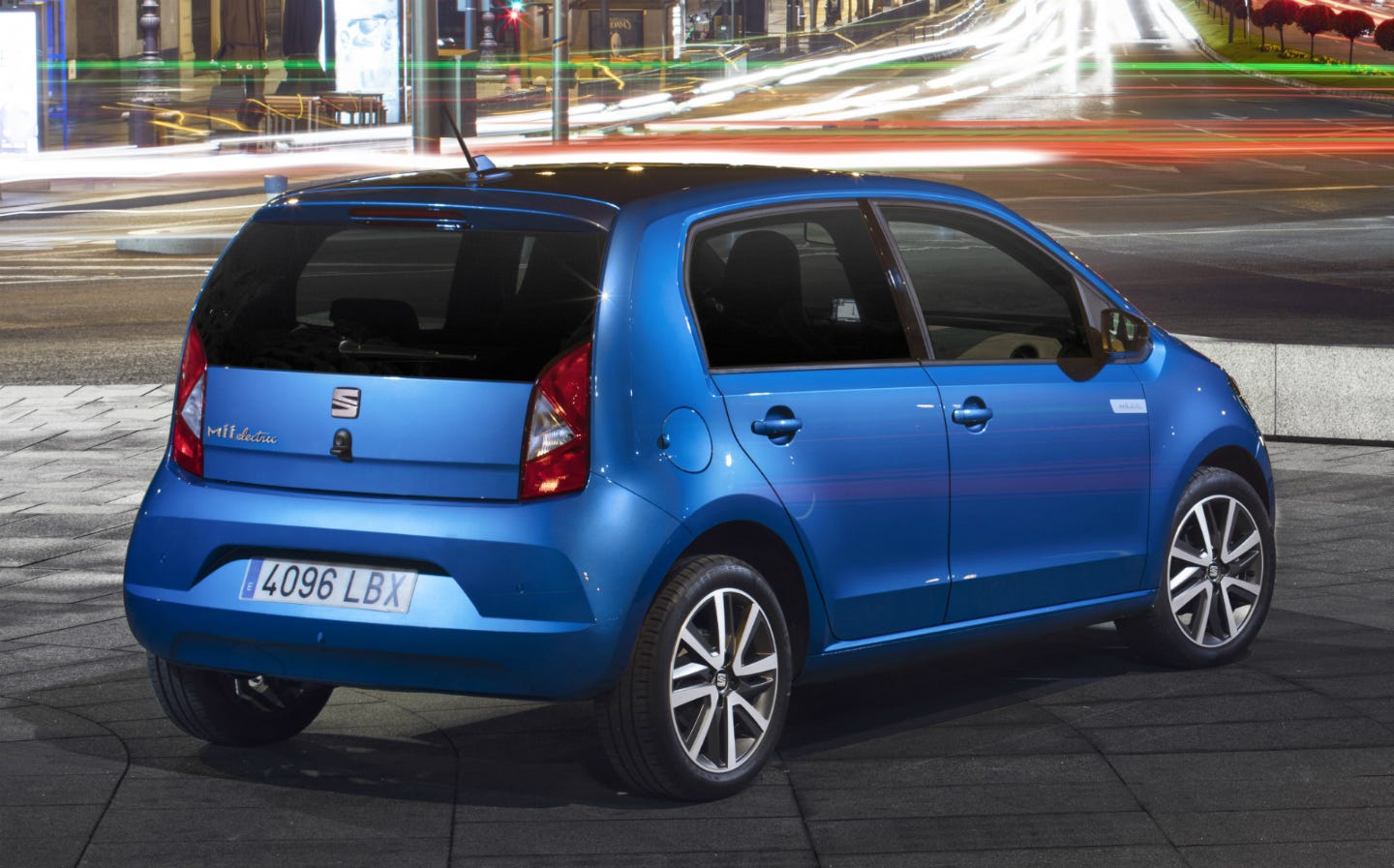SEAT e-Mii
Hello, electric car lovers! In this blog, I cover all the latest tech news surrounding electric cars. I cover the background, feel and drive, the current selling price, and the specs and engineering that go into making each car. If you have an electric car that you’d like me to cover let me know in the comments below. In today's article, I’m reviewing the new and upcoming SEAT e-Mii. I’ll cover the most important features to see whether it stands against the competition. Oh, and one more thing before I start - If I flip my new Nissan electric car...
Okkaayyyy... Now back to the article.
Background
Marketed since the end of 2019, the electric Seat Mii uses the same technical basis as the Skoda Citigo e iV and allows a range of up to 161 miles.
It's time to say goodbye to the Seat Mii city car's gasoline engine and hello to the Seat Mii Electric. If you believe that the new Mii Electric is virtually identical to the outgoing Mii, with the exception of the 'Electric' badge, you are quite accurate. And, if you believe this car looks a lot like the Skoda Citigo or the Volkswagen Up, you're not far off the mark.
It was back in 2012 that the Volkswagen Group's Up, Citigo, and Mii were all unveiled in rapid succession — three practically similar, extremely outstanding city vehicles that were developed as a collaborative effort by the formidable Volkswagen Group. However, because it is tough to earn money at this end of the market these days, and because city car sales are dropping and interest in electric vehicles is increasing, all three of these vehicles are receiving electric makeovers. As the first all-electric model from the Spanish automaker, the SEAT Mii Electric is one of the cheapest new electric vehicles available on the market. This compact hatchback is a viable alternative to hybrid vehicles such as the Nissan Leaf, but its smaller size makes it even better suited for zipping through rush hour traffic and slipping into tiny parking spots.
The world has already seen an electric Volkswagen Up, which was named the e-Up and proved to be a disappointment. With a restricted real-world range and a prohibitively expensive list price, it was just not recommendable. This Mii Electric, on the other hand, appears to have all of the necessary characteristics to be a commercial hit. The most notable features are a stated electric range of 161 miles and one of the most affordable price tags for an electric vehicle.
Is it, however, the most stunning little electric vehicle now on the market? Are there any disadvantages to using it? In addition, how does it fare in important areas when compared to other electric competitors such as the Renault Zoe?
Continue watching to find out.
Design and Engineering
The SEAT Mii Electric is the same size as the conventional Mii, but owing to its nimble electric engine, it's Said to be even more enjoyable to drive in urban environments. Only a pair of 'electric' emblems distinguishes this vehicle as an electric vehicle, until you open what was once the fuel filler cap, which is where you'll discover the charging station for the vehicle.
There is only one model level, which comes standard with 16-inch alloy wheels, metallic paint, and LED daytime running lights. There is no optional equipment. A roof with a striking contrast of black is available as a no-cost alternative. When it comes to these characteristics, the SEAT Mii Electric is quite comparable to the Renault Zoe, however it does not quite match Renault's sci-fi design aesthetic. Certainly, it appears to be more akin to a spaceship's tumble dryer than a high-speed escape pod, to put it another way. Another problem is that this isn't an electric vehicle that makes a big deal about its environmental credentials.
16-inch alloy wheels, metallic paint, and LED daytime running lights.
Interior
In comparison to its competitors, the Mii Electric feels a little old on the inside according to reviews. The Mii is an ancient design, and while the cabin is substantial, the materials utilized aren't; there's a lot of reported harsh, scratchy plastic, and the steering wheel is said to feel particularly cheap. However, there is a bright, creatively fashioned plastic strip across the dash to add some color. The Renault Zoe, on the other hand, appears more polished and contemporary.
A touchscreen infotainment system is also missing from the Mii. Instead, a phone holder with a color screen and tactile shortcut buttons is installed on top of the dash, allowing you to cycle through your phone's features through a smartphone-integration program. You may also use the app to lock and unlock the car and set the air conditioning before getting in. Although it is not as cutting-edge as a touchscreen infotainment panel, it is still a viable option. A system with Apple CarPlay or Android Auto, on the other hand, would be easier to operate.
The driving posture is reported to be comfortable, but the steering wheel adjusts only up and down, not in and out, and depending on how you set it, it may partially obscure your view of the instrument panel. The backrest of the seat adjusts with a ratchet lever rather than a rotary wheel, so getting the exact angle you desire may be difficult. There's also no lumbar support that may be adjusted. Meanwhile, the trip computer display appears to be a little out of date, thanks to its tiny size and low screen resolution, which contrasts sharply with the Zoe's completely digital display.
The visibility out of the automobile is rated excellent in all directions. That's especially excellent news because, while rear parking sensors are standard, front parking sensors and a rear-view camera aren't even listed as options. Super-bright LED headlights, which come standard on the Zoe, are also not available.
Performance
How does it fare in terms of performance? Well, the electric engine produces 61 kilowatt and 156 pound-feet of torque, and although that may not sound like much, you can be quite certain of humiliating most other vehicles off the line at the traffic lights with this combination. Outside of city limits, however, the Renault Zoe has a distinct edge in terms of acceleration.
Despite the fact that the Mii is capable of handling highway travels (albeit its highest speed is limited to 81mph), its acceleration at higher speeds is stated to be less flexible than it is while driving at lower speeds. A simple squeeze of the right foot is all it takes to move into another lane of traffic in town, but getting an equivalent burst of speed while overtaking on a freeway is far more difficult.
Normal, Eco, and Eco+ are the three driving modes available. When compared to the others, Normal provides the most power while the others reduce it in order to maximize range (Eco+ even turns off the air conditioning). Regenerative braking levels (a system that captures energy that would otherwise be squandered when braking and utilizes it to recharge the battery) may also be adjusted using the gear selector. The braking force generated when you pull your foot off the accelerator is promised to be strong enough to bring the car to a near halt, but it is not nearly as efficient as the Nissan Leaf's technology, which allows for one-pedal operation.
The brake pedal, on the other hand, seems natural and consistent in its reactivity - something that cannot always be said for electric vehicles.
According to expert reviews, driving the Mii Electric in and around town is a pleasurable experience. Light and precise steering are provided by the vehicle, and the vehicle's tiny, boxy shape makes it easy to maneuver through tight side roads. A small turning circle is also beneficial.
There are several notable aspects of the ride quality, including how well it tackles major road irregularities such as speed bumps and potholes while remaining composed at all speeds. It's also rather quiet — at highway speeds, you might hear some windy wind noise thrown up around the door mirrors, but otherwise there's nothing stated that would disturb the tranquility.
Battery Life
Let's start with the capabilities of the Mii Electric. According to the WLTP test cycle, the Mii Electric's 36.8kWh lithium ion battery would offer enough power for it to go 161 miles on a single charge, according to the manufacturer. Also, WLTP numbers imply that it will be able to travel further than a Volkswagen e-Golf (144 miles), while many other electric vehicles will be able to travel even further.
Still, the Mii Electric's 161-mile range isn't too shabby when compared to the competition, and, more importantly, it's substantially less expensive than its closest competitors – something I'll go into more depth about later.
A 7kW home charger will take around four hours to charge the battery from 0 to 80 percent capacity, but a 40kW quick charger would do the task in one hour. If you use a three-pin connection, it will charge in 13-16 hours, but you'll have to spend extra for the charging cable, which is a bummer because it isn't included with the car. These charging periods are comparable to those of competitive electric vehicles.
Price and Model Range
The Seat Mii Electric is one of the most affordable electric vehicles available; a Renault Zoe, on the other hand, is significantly more expensive. Yes, it's still significantly more expensive than similar petrol-engined city cars, but the Mii Electric's pricing is a genuine bargain when compared to other electric vehicles.
With the trim costing around $23,000, There is just one model level offered, which comes equipped with 16-inch alloy wheels, air conditioning, cruise control, automatic wipers, and heated seats as standard equipment. With so few alternatives available, you shouldn't have to think about what else you want to put in place.
Seat finished 15th overall out of 31 manufacturers in the Reliability Survey.
For eight years or 100,000 miles, the Mii Electric's battery is covered under warranty, and it is guaranteed to retain 70 percent of its capacity or it will be replaced at no cost to the customer. This policy is comparable to those of competitors.
This wraps up my review of The SEAT e-Mii, let me know what you think of it. Thank you for sticking it out through to the very end of this article! Nothing helps out my blog more than y’all reading the entire article. These articles take a long time to make and are a labor of love. If you would like to see my blog grow, please help spread the word and until next time, remember, the best experiences aren’t about where you end up, but who you’re lucky enough to be on the journey with.







